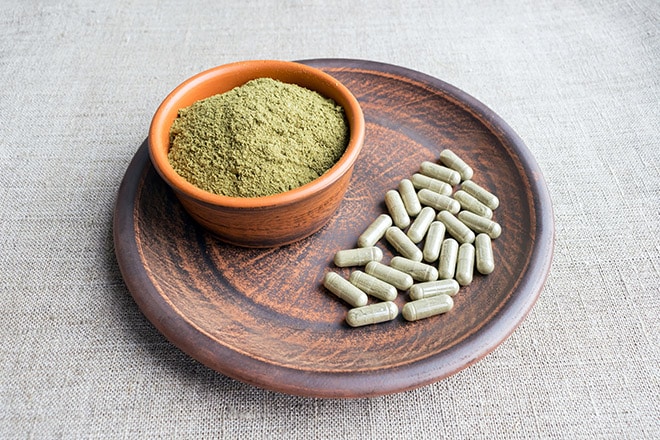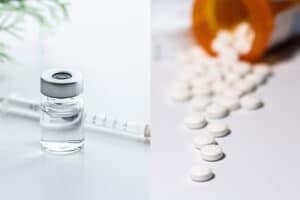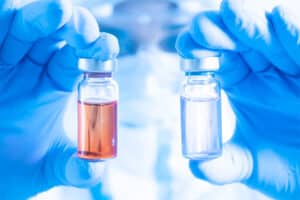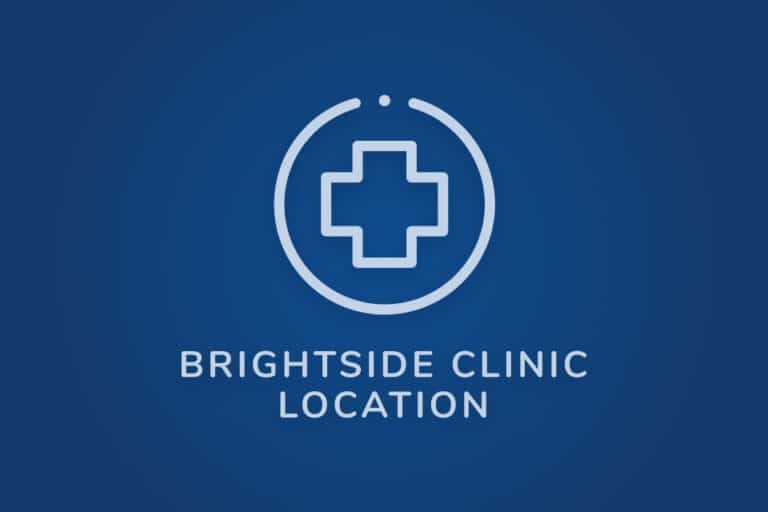7-hydroxymitragynine (7-OH) is increasingly found in “herbal” shots, gummies, drinks, vapes, and capsules. Unlike traditional plant material like kratom that contains only trace amounts of 7-OH, today’s retail products often include concentrated or chemically derived 7-OH that behaves like a potent opioid.
Because of their similarities to illicit opioids, using these “herbal” products raises the risk of dependence, overdose, and withdrawal. Recent FDA actions reflect the mounting public health concern about these items, as they become more easily available in vape shops, gas stations, and online.
In this article, we explain what 7-OH is, explore the real dangers of these products, why their use is spreading, and why consumers and regulators are sounding the alarm. While natural kratom leaf contains only trace levels of 7-OH, concentrated or chemically modified products can deliver much stronger, opioid-like effects. If you or a loved one is using these products, talk to Brightside Recovery about safe, evidence-based treatment options.
Defining 7-OH: Why Are Today’s Products Different?
7-OH is a semi-synthetic/derivative alkaloid that powerfully activates mu-opioid receptors in the brain. In natural leaf material, 7-OH exists only in tiny amounts. The danger comes from today’s concentrated or chemically modified products that deliver far higher doses than would be encountered in traditional use.
These retail items are marketed as “natural” but can produce strong, opioid-like effects with all the attendant risks. The FDA has even issued warning letters to multiple companies that are illegally marketing 7-OH products.
What’s changed recently is how these products are formulated and sold. Highly potent derivatives like 7-OH and “Pseudo” (mitragynine pseudoindoxyl) have been mass-produced and widely distributed, fueling addiction and safety concerns. Alongside traditional leaf or powder products, manufacturers now sell drinks, “energy” shots, gummies, vapes, and capsules with concentrated 7-OH or related compounds.
Hospitals, ERs, and addiction clinics are noticing that people who started using these products for their advertised effects find themselves trapped by escalating use, withdrawal symptoms, and mounting financial and health costs. Federal regulators have also recommended scheduling 7-OH under the Controlled Substances Act, pointing to opioid-like risks and widespread retail availability.
Why 7-OH and Pseudoindoxyl Raise Overdose and Withdrawal Risks
7-OH binds strongly to mu-opioid receptors and can be more potent than morphine. That potency is why users report effects similar to prescription opioids and why medical teams now see:
- Respiratory depression
- Escalating daily use and tolerance
- Significant withdrawal
- ICU-level emergencies when mixed with alcohol, benzodiazepines, sleep meds, or other opioids
Bottom line: trace amounts in natural material are not the same as today’s concentrated 7-OH products. These versions create unpredictable, dangerous outcomes, especially if used without medical supervision.
What People Actually Experience (Beyond the Label)
Because of the convoluted marketing around 7-OH products, it can be difficult to determine how they actually make you feel. On lower doses, people often report that the short-term effects mirror prescription opioids:
- Euphoria
- Sedation
- Nausea
- Dizziness
- Agitation
However, at higher doses or when mixed with other sedatives, the risks grow. Patients may experience dangerously slowed breathing and poison center data shows serious events and deaths where 7-OH was detected, usually alongside other substances. This is a primary reason public-health agencies actively track kratom-involved outcomes and warn clinicians to ask specifically about 7-OH products.
How Untrained Staff and Contaminated Products Add to the Serious Safety Problem
Despite FDA warnings and prohibitions on medical claims, untrained clerks at gas stations, vape shops, and CBD stores often sell 7-OH substances and recommend them for all kinds of ailments, downplaying or ignoring the risks. Unlike regulated pharmaceuticals, these compounds haven’t undergone the rigorous research, safety testing, or clinical trials that ensure drugs are safe for public use.
7-OH and pseudoindoxyl products are also plagued by issues of standardization and lab testing. The United States market lacks consistent regulation, meaning products can vary significantly in strength, purity, and safety depending on the batch and the brand.
Many are contaminated, with studies finding heavy metals, pesticides, microbes, and even other synthetic opioids in products, especially those not subjected to third-party lab testing. Certificates of Analysis (COAs) are rare, outdated, or unreliable, even within reputable brands. An amount of 7-OH that felt tolerable one day may have drastically different effects on another day due to these inconsistencies.
These issues can have significant adverse effects for consumers, including:
- Variable Potency: Because products often have unclear or differing potencies, each dose will have unpredictable effects.
- Contamination Risk: Products that unintentionally include heavy metals, pesticides, and microbes can cause significant harm when ingested.
- Adulteration: Whether in the product or used alongside it, synthetic opioid-like mixers can greatly increase overdose risk.
- Limited Testing: Few kratom products meet the robust, independent safety standards required for FDA approval.
Who’s Most at Risk
Everyone faces uncertainty with unlabeled potency, but people with current or past opioid, alcohol, or benzodiazepine use are at higher risk for respiratory depression or overdose. The combination of high potency, easy access, and unclear labeling is what pulls many patients into daily use, tolerance, and withdrawal.
Youth and younger adults are another concern because flavored shots, gummies, and vapes can look innocuous on social media and in convenience stores. States have responded with age limits (18 or 21+), local bans, and enhanced labeling, but federal regulation is still pending, leaving patchwork protections that often fail in retail settings. Parents and caregivers should be especially vigilant: these substances are increasingly linked to youth exposure and accidental overdose.
Regulation and Public Health Responses to 7-OH Risks
The FDA classifies 7-OH and similar synthetic kratom derivatives as illegal under current dietary supplement and food laws, issuing warnings and enforcing misleading claims and untested products. States like Florida, Mississippi, Louisiana, and Colorado have taken steps to ban or restrict these high-potency derivatives, tighten age limits, and require compliance with safety standards.
International agencies are issuing warnings as well, emphasizing the need for better labeling, toxicology screening, and consumer education. The central theme across these actions is that 7-OH concentrates are not lawful dietary ingredients and pose opioid-like risks, regardless of “herbal” branding.
What to Do If You’re Already Using 7-OH Products
If you’re using 7-OH regularly, suddenly stopping can trigger significant withdrawal. Brightside Recovery can help you transition to safer, evidence-based treatment. Buprenorphine reduces cravings and overdose risk and, when paired with counseling, supports long-term recovery.
While you’re arranging treatment, avoid mixing these products with alcohol, benzodiazepines, sleep medications, or other opioids, and keep naloxone on hand if you or someone close to you uses any opioid-like product. Seek emergency care for blue/gray lips, extreme sleepiness, or slowed/absent breathing. These recommendations align with current overdose-prevention guidance and the FDA’s clinical communications around 7-OH.
Frequently Asked Questions About 7-OH Products
Is 7-OH an opioid?
It is not morphine or oxycodone, but it strongly activates the same mu-opioid receptors. Clinically, that means 7-OH behaves like an opioid and carries similar risks for dependence, overdose, and withdrawal.
Does 7-OH really help with pain, mood, and energy?
All these claims are not scientifically proven, and due to the lack of required lab testing, standardization, and FDA approval, many products lack reliable dosing and quality controls. This significantly raises opioid-like risks and the possibility of dependence without proven benefits like pain relief and mood support.
What are the effects of 7-OH?
The effects of 7-OH are often unpredictable due to variable product potency and the presence of other substances or contaminants. Consuming products with 7-OH can cause:
- Euphoria or a “high” like strong opioids
- Sedation and drowsiness
- Respiratory depression (slowed breathing)
- Nausea, vomiting, constipation, and dizziness
- Agitation or confusion
- Physical and psychological dependence with difficult withdrawal
- Overdose, sometimes requiring emergency or ICU care
How common are serious events caused by 7-OH?
Poison control centers have reported dozens to hundreds of confirmed 7-OH exposure cases, especially in states with readily available concentrated products. For example, on July 1, 2025, the Mississippi Poison Control Center (MPCC) received 21 exposure-related calls since the beginning of the year.
Access Compassionate Treatment for 7-OH Dependence at Brightside Recovery
7-OH mitragynine and pseudoindoxyl are hidden opioid-like threats in today’s rapidly evolving “herbal” market. While the promise of pain relief or wellness draws interest, the reality of poor product quality, lack of credible evidence, and dangers from contamination make these substances unpredictable and hazardous. Robust regulation, transparent lab testing, and public awareness are urgently needed, especially as exposure risks rise for children, teens, and vulnerable adults.
Brightside Recovery provides confidential, evidence-based care to help you recover from 7-OH dependence. Our 7-OH addiction program builds a plan that fits your goals, provides medication-assisted treatment, and coordinates counseling, ensuring you get the support you need.
If you or a loved one is struggling with 7-OH dependence, connect with Brightside to start your recovery journey.












